litewskie odmiany
Nazwa
Endolingwonim w literackim języku litewskim to lietuvių kalba, czyli dosłownie ‘mowa Litwinów’.Ethnologue[1
 przyp01 / komentarz/comment /
przyp01 / komentarz/comment / http://www.ethnologue.com/language/lit
 ] podaje kilka różnych lingwonimów dla języka litewskiego:
] podaje kilka różnych lingwonimów dla języka litewskiego:w języku angielskim - Lithuanian
niemieckim - Litauisch
rosyjskim - литовский язык
białoruskim - літоўская мова
łotewskim - lietuviešu valoda
łatgalskim - lītaunīku volūda
W języku litewskim wyróżnia się dwa podstawowe dialekty:
- auksztocki ~ auksztajcki (lit. aukštaičių tarmė), czyli górnolitewski (ang. High Lithuanian)
- żmudzki (lit. žemaičių tarmė), czyli dolnolitewski (Low Lithuanian)
 przyp02 / komentarz/comment /
przyp02 / komentarz/comment / http://www.tarmes.lt/index_meniu.php?id=1
 ]:
]:- zachodnioauksztocka (vakarų aukštaičių patarmė)
- południowoauksztocka (pietų aukštaičių patarmė)
- wschodnioauksztocka (rytų aukštaičių patarmė)
 przyp03 / komentarz/comment /
przyp03 / komentarz/comment / http://www.tarmes.lt/index_meniu.php?id=1
 ]:
]: - zachodniożmudzki (vakarų žemaičių patarmė)
- północnożmudzki (šiaurės žemaičių patarmė)
- południowożmudzki (pietų žemaičių patarmė)
Historia i geopolityka
Współcześnie mniejszość litewska w Polsce posługuje się gwarami: zachodnioauksztocką i południowoauksztocką, a coraz większy wpływ odgr. Zamieszkuje północno-wschodnią część województwa podlaskiego, na Suwalszczyźnie, wzdłuż granicy z Litwą od wsi Markiszki (Morkiškė) i Podlaski (Padliaskai) na południowym wschodzie do wsi Jegliniec (Eglinė) i Wojciuliszki (Vaičiuliškė) na północnym zachodzie (Hasiuk 1978: 3 Hasiuk 1978 / komentarz/comment/r /
Hasiuk 1978 / komentarz/comment/r / Hasiuk, Michał 1978. Fonologia litewskiej gwary sejneńskiej. Poznań: Wydawnictwo Naukowe Uniwersytetu im. Adama Mickiewicza
 ). We wczesnym średniowieczu, do początku XIII w. ziemie te były zamieszkiwane przez Jaćwingów (Jotvingiai)[4
). We wczesnym średniowieczu, do początku XIII w. ziemie te były zamieszkiwane przez Jaćwingów (Jotvingiai)[4 przyp04 / komentarz/comment /
przyp04 / komentarz/comment / Plemiona bałtyckie dawniej zamieszkujące tereny Suwalszczyzny, http://sudawia.pl/osada-sudawia/jacwingowie/
 ]. Porastała je puszcza, którą dopiero ok. XV w. zaczęli ponownie Litwini, Rusini a także Polacy[5
]. Porastała je puszcza, którą dopiero ok. XV w. zaczęli ponownie Litwini, Rusini a także Polacy[5 przyp05 / komentarz/comment /
przyp05 / komentarz/comment / http://www.punsk.com.pl/wordpress/lt/?page_id=6
 ].
].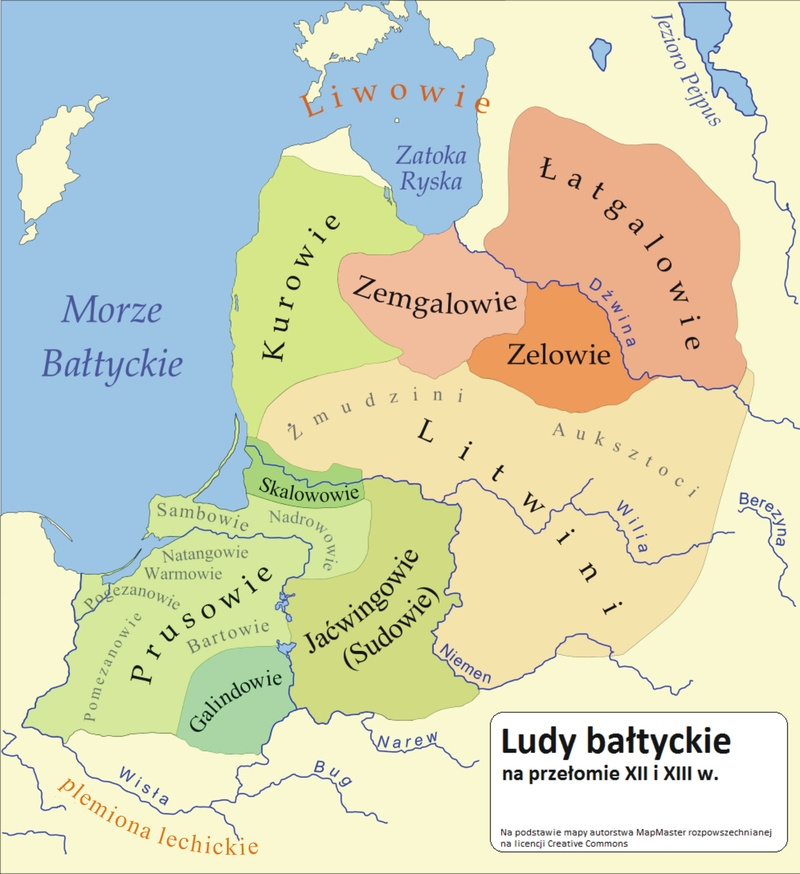
Ludy bałtyckie na przełomie XII i XIII w. [red.mapy: Jacek Cieślewicz, na podstawie http://pl.wikipedia.org/w/index.php?title=Plik:Baltic_Tribes_c_1200PL..svg ]
Na obszarze tym, szczególnie wśród szlachty, dochodziło do polsko-litewsko-(biało)ruskich kontaktów językowych. Od połowy XVI w. język ojczysty (litewski lub białoruski) zaczął ustępować miejsca białoruskiemu, a później polskiemu. Urzędowym (kancelaryjnym) językiem Wielkiego Księstwa Litewskiego był ruski (w odmianie starobiałoruskiej), natomiast po Unii Lubelskiej coraz powszechniej używanym językiem był język polski. Język litewski miał niski status i uważany był za język prostych chłopów (Marcinkiewicz 2003: 35
 Marcinkiewicz 2003 / komentarz/comment/r /
Marcinkiewicz 2003 / komentarz/comment/r / Marcinkiewicz, Józef 2003. Polsko-litewskie kontakty językowe na Suwalszczyźnie. Poznań: Zakład Graficzny UAM.
 ).
).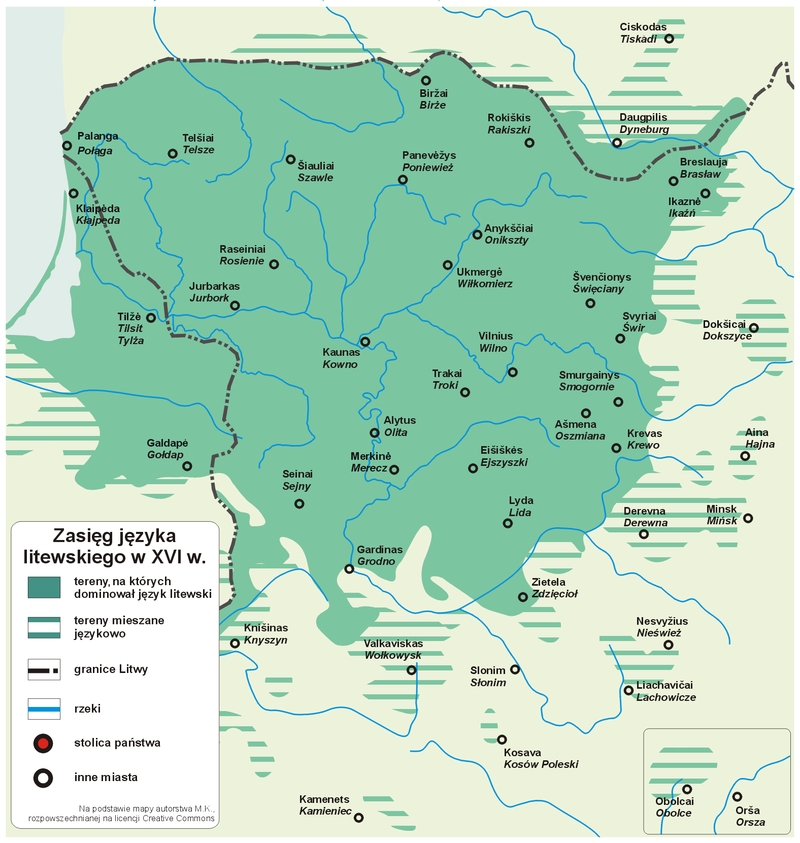
Zasięg języka litewskiego w XVI wieku. [red.mapy: Jacek Cieślewicz, na podstawie http://en.wikipedia.org/wiki/File:Lithuanian_language_in_the_16th_century.png]
Po trzecim rozbiorze Rzeczypospolitej Suwalszczyzna trafiła pod panowanie pruskie. Po dwunastu latach w zaborze pruskim znalazła się w granicach Księstwa Warszawskiego, a następnie Królestwa Polskiego pod zaborem rosyjskim, gdzie po nowym podziale królestwa należała do woj. augustowskiego, później przemianowanego na gubernię augustowską, a jeszcze później - na gubernię suwalską. Ten stan utrzymywał się aż do I wojny światowej, a w zasadzie do 1919 r. tzn. do traktatu wersalskiego, wycofania się Niemców z Suwalszczyzny i powstania niepodległych państw (Marcinkiewicz 2003: 39
 Marcinkiewicz 2003 / komentarz/comment/r /
Marcinkiewicz 2003 / komentarz/comment/r / Marcinkiewicz, Józef 2003. Polsko-litewskie kontakty językowe na Suwalszczyźnie. Poznań: Zakład Graficzny UAM.
 ).
).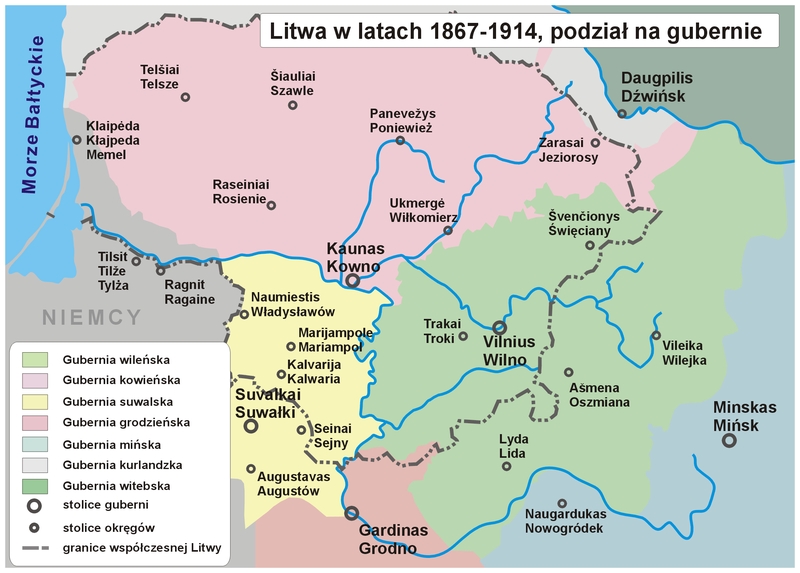
Litwa w latach 1867-1914, podział na gubernie. [red.mapy: Jacek Cieślewicz, na podstawie http://upload.wikimedia.org/wikipedia/commons/b/b3/Lithuania-1867-1914.svg]
Według rosyjskich danych statystycznych z 1897 r. w guberni suwalskiej mieszkało ok.:
52% Litwinów,
23% Polaków,
10% Żydów,
9% Rosjan (wraz ze Staroobrzędowcami i Białorusinami),
5% Niemców
i 1,5% innych narodowości.
Późniejsza statystyka z 1910 r. wykazała ok. 55% Litwinów i 30% Polaków, zaś pozostałą cześć stanowiły inne narodowości (Marcinkiewicz 2003: 40
 Marcinkiewicz 2003 / komentarz/comment/r /
Marcinkiewicz 2003 / komentarz/comment/r / Marcinkiewicz, Józef 2003. Polsko-litewskie kontakty językowe na Suwalszczyźnie. Poznań: Zakład Graficzny UAM.
 ).
).Na początku XX w. jednym z najważniejszych ośrodków oświatowych pobudzających świadomość narodową Litwinów były Sejny (Seinai). W tamtejszym Seminarium Duchownym wykształciło się wielu litewskich księży, pisarzy i działaczy kulturalno-oświatowych. W seminarium działały tajne litewskie towarzystwa kleryków, których celem było nauczanie miejscowej ludności języka litewskiego oraz krzewienie oświaty, prasy litewskiej i ducha narodowego. W tym czasie język litewski nie był jeszcze unormowany i nie posiadał podręczników, słowników (normatywnych) ani gramatyk. Dzięki działającej w latach 1906-1915 drukarni regularnie wydawano litewskie czasopisma Šaltinis (‘Źródło’), Spindulys (‘Promień), Vadovas (‘Przewodnik’), kalendarz Žiburys (‘Światło’) oraz setki litewskich książek (Marcinkiewicz, 2003: 43
 Marcinkiewicz 2003 / komentarz/comment/r /
Marcinkiewicz 2003 / komentarz/comment/r / Marcinkiewicz, Józef 2003. Polsko-litewskie kontakty językowe na Suwalszczyźnie. Poznań: Zakład Graficzny UAM.
 ). Jednym z największych poetów litewskich, romantykiem i obrońcą języka litewskiego był Antoni Baranowski (Antanas Baranauskas), biskup sejneński. Największą sławę zdobył dzięki poematowi romantycznego Borek Oniksztyński (Anykščių Šilelis), który stworzył pod wpływem Pana Tadeusza Adama Mickiewicza (Jackiewicz 2003: 106
). Jednym z największych poetów litewskich, romantykiem i obrońcą języka litewskiego był Antoni Baranowski (Antanas Baranauskas), biskup sejneński. Największą sławę zdobył dzięki poematowi romantycznego Borek Oniksztyński (Anykščių Šilelis), który stworzył pod wpływem Pana Tadeusza Adama Mickiewicza (Jackiewicz 2003: 106 Jackiewicz 2003 / komentarz/comment/r /
Jackiewicz 2003 / komentarz/comment/r / Jackiewicz, Mieczysław 2003. Dzieje literatury litewskiej do 1917 roku. Tom 1. Warszawa: Ex Libris.
 ).
).Po uzyskaniu niepodległości przez zarówno przez Polskę jak i Litwę w 1918 r., południowa część Suwalszczyzny jak i Wileńszczyzna znalazły się w granicach II Rzeczpospolitej. Według spisu ludności w 1931 r. w Polsce mieszkało 82.313 Litwinów. Natomiast dane z 1939 roku podają, że na terenie II RP mieszkało ok. 250 tysięcy Litwinów (Makowski 1986: 22-30
 Makowski 1986 / komentarz/comment/r /
Makowski 1986 / komentarz/comment/r / Makowski, Bronisław. 1986. Litwini w Polsce 1920-1939. Warszawa: PWN.
 ).
).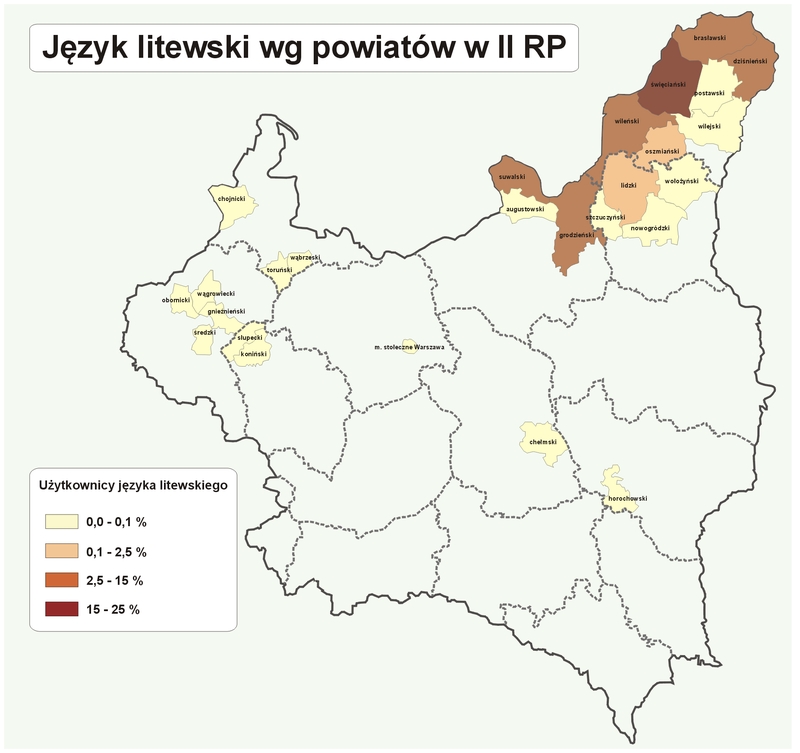
Język litewski w II Rzeczypospolitej (wartość podana w %). [red.mapy: Jacek Cieślewicz, na podstawie http://en.wikipedia.org/wiki/File:LitewskiIIRP.PNG]
Podczas II wojny światowej liczba Litwinów na Suwalszczyźnie zmalała, szczególnie w okolicach Rutki-Tartak (Rutka Tartakas) i Wiżajn (Vižainis), gdzie przed wojną stanowili ok. 25% ludności. Pod presją wyjeżdżali na Litwę bądź zostali zmuszeni przez Niemców do tzw. repatriacji (zwłaszcza Litwini z okolic Sejn i Puńska). Znaczna część z nich już w granice Polski nie wróciła (Marcinkiewicz 2003: 45
 Marcinkiewicz 2003 / komentarz/comment/r /
Marcinkiewicz 2003 / komentarz/comment/r / Marcinkiewicz, Józef 2003. Polsko-litewskie kontakty językowe na Suwalszczyźnie. Poznań: Zakład Graficzny UAM.
 ).
).Od 1 września 1952 r. za zezwoleniem władz PRL, w szkołach na terenie gminy Puńsk zostały otwarte klasy z litewskim językiem nauczania (otwarto 4 takie szkoły, w których uczyło się 160 uczniów). Rok później w liceum ogólnokształcącym w Suwałkach została utworzona klasa z językiem litewskim. Po trzech latach otwarto Liceum Ogólnokształcące z litewskim językiem nauczania oraz Dom Kultury Litewskiej (Lietuvių kultūros namai) w Puńsku (Punskas) (Marcinkiewicz 2003: 46-47
 Marcinkiewicz 2003 / komentarz/comment/r /
Marcinkiewicz 2003 / komentarz/comment/r / Marcinkiewicz, Józef 2003. Polsko-litewskie kontakty językowe na Suwalszczyźnie. Poznań: Zakład Graficzny UAM.
 ).
).Obecnie polscy Litwini żyją w najbardziej na północny wschód wysuniętym krańcu Polski. Najwięcej z nich mieszka w okolicach Puńska, gdzie stanowią zdecydowaną większość mieszkańców (ok. 80%), w Sejnach zaś i ich okolicach Litwini stanowią znaczącą mniejszość (ok. 30-40%) wszystkich mieszkańców. Litewskie wsie znajdują się również w okolicy Krasnopola (Krasnopolis) czy Szypliszek (Šipliškės). Sporo Litwinów mieszka także w Suwałkach – szczególnie przez ostatnie lata ich liczba się zwiększyła, ze względu na poszukiwanie pracy poza wsią. Część Litwinów poprzez migracje rozproszyła się po całej Polsce, szczególnie po północnej i zachodniej jej części (Gdańsk, Olsztyn, Szczecin, Wrocław), a także w Warszawie. W Spisie Powszechnym 2002 r. 5.696 obywateli polskich zadeklarowało używanie języka litewskiego w kontaktach domowych; w Spisie z roku 2011 deklarację narodowości litewskiej złożyło ponownie ok. 6 tysięcy osób.
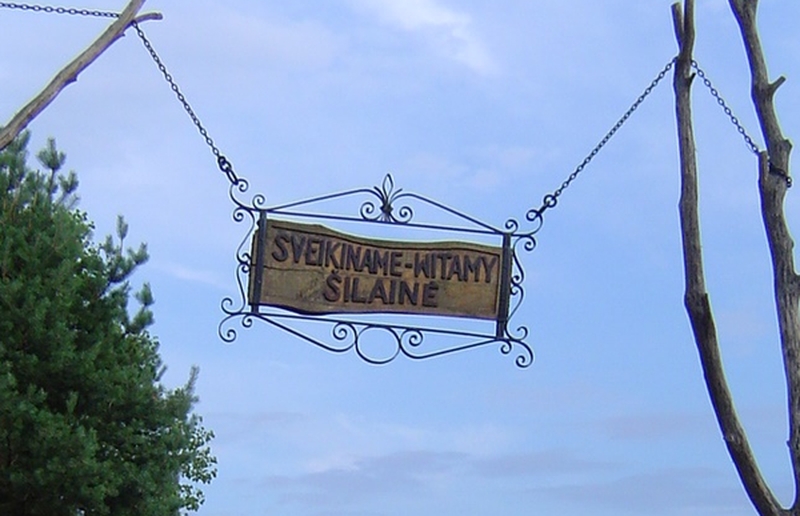
Dwujęzyczna tablica powitalna. Fot. T. Wicherkiewicz
Oprócz Polski język litewski używany jest także w byłych krajach Związku Radzieckiego (Łotwa i Białoruś jako autochtoniczny język mniejszościowy; poza tym Estonia, Białoruś, Rosja, Kazachstan, Kirgistan, Tadżykistan, Turkmenistan, Uzbekistan), w Wielkiej Brytanii, Ameryce Północnej (Stany Zjednoczone Ameryki, Kanada) oraz Południowej (Argentyna, Brazylia, Urugwaj)[6
 przyp06 / komentarz/comment /
przyp06 / komentarz/comment / http://www.ethnologue.com/language/lit
 ].
]. Kod ISO
ISO 639-1 lt
ISO 639-2 lit
ISO 639-3 lit
The Linguasphere 54-AAA-a
ISO 639-2 lit
ISO 639-3 lit
The Linguasphere 54-AAA-a
- przyp01
- przyp02
- przyp03
- przyp04
- przyp05
- przyp06
- przyp07
- przyp08
- przyp09
- przyp10
- przyp11
- przyp12
- przyp13
- przyp14
- przyp15
- przyp16
- przyp17
- przyp18
- przyp19
- przyp20
- przyp21
- przyp22
- przyp23
- przyp24
- przyp25
- przyp26
- przyp27
- przyp28
- przyp29
- przyp30
- przyp31
- przyp32
- przyp33
- przyp34
- przyp35
- przyp36
- przyp37
- przyp38
- przyp39
- przyp40
- przyp41
- przyp42
- przyp43
- przyp44
- przyp45
- przyp46
- przyp47
- przyp48
- przyp49
- przyp50
- Hasiuk 1978
- Marcinkiewicz 2003
- Jackiewicz 2003
- Vaičiulytė-Romančuk 2006
- Niewulis 2005
- Zinkevičius 1978
- Tarnaiskaitė 2009
- Butkus 2011
- Jovaišas 1999
- Zinkevičius 1996
- Makowski 1986
- zagrożenie języków / language endangerment
- Godło Dzukiji
- Proste małe kanklės
- Kanklės z pulpitem
- Ludowy zespół muzyczny grający na gęślach
- Najstarszy litewski manuskrypt (pacierz) napisany
- Pierwsza strona Katechizmu Mażwida
- Ludy bałtyckie na przełomie XII i XIII w.
- Zasięg języka litewskiego w XVI wieku
- Litwa w latach 1867-1914, podział na gubernie
- Język litewski w II Rzeczypospolitej
- Gwary litewskie
- Etnograficzne regiony Litwy
- Dwujęzyczna tablica powitalna
- Gwary litewskie wg Zdancewicza
- Zbiór przedmiotów muzeum etnograficznego w Puńsku
- Przykłady strojów kobiecych
- Męski strój ludowy
- Piosenka ludowa w gwarze Dzuków 1
- Piosenka ludowa w gwarze Dzuków 2
- Akcentuacja wyrazów
- Tablica liceum w Puńsku
- Tablica szkoły podstawowej w Przystawańcach
- Podręczniki do szkoły podstawowej po litewski
- Tablica Domu Kultury w Puńsku
- Okładka dwutygodnika Aušra
- Okładka miesięcznika Aušrelė
- Publikacje o Litwinach w Polsce
- Publikacja o folklorze mniejszości litewskiej
- podręcznik do historii Litwy i regionu
- Podręcznik w języku litewskim